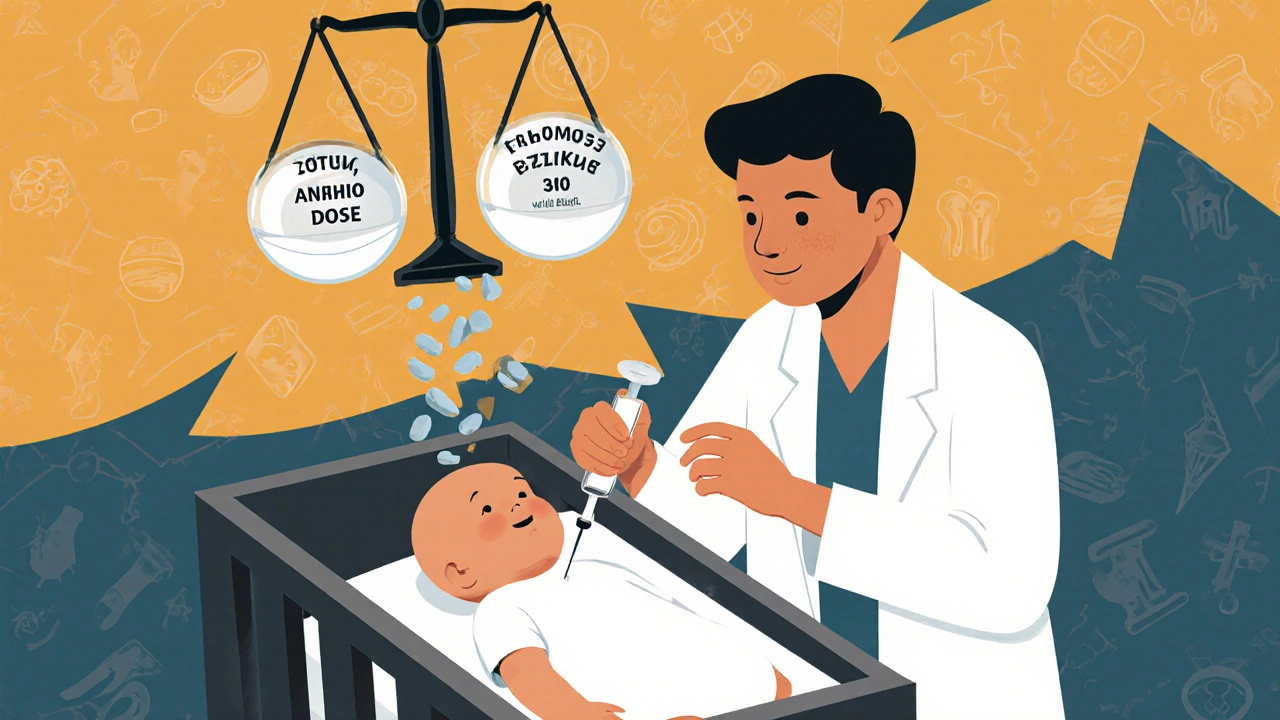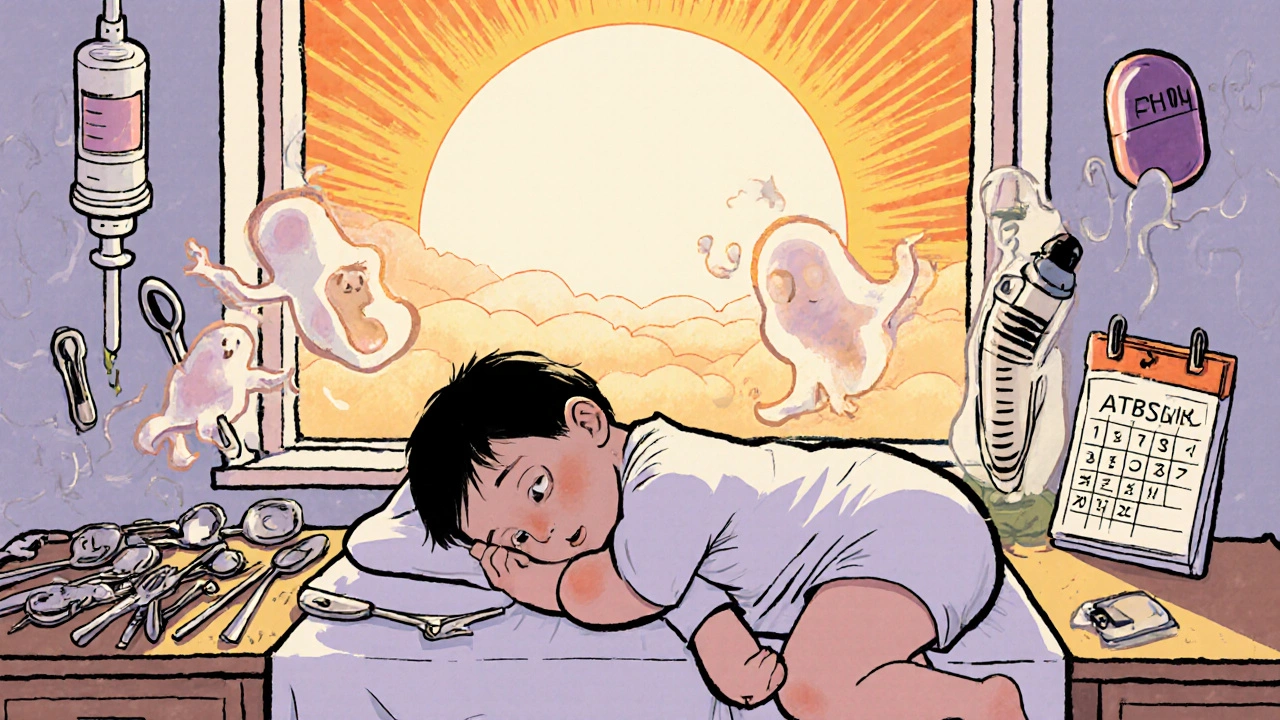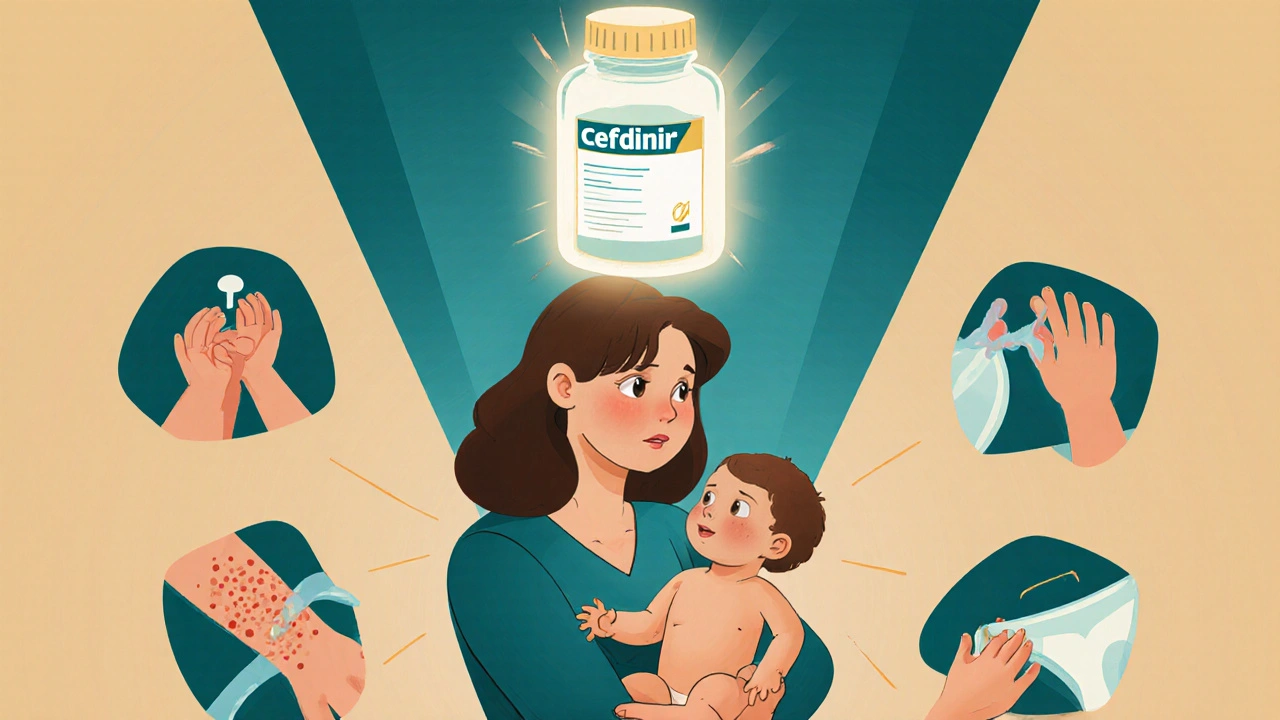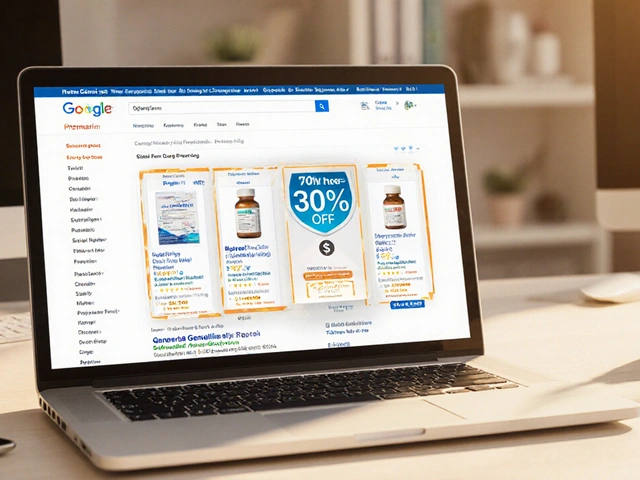When your baby is sick with a fever, ear infection, or persistent cough, the last thing you want is to guess whether the medicine is safe. Cefdinir is one of the antibiotics doctors commonly prescribe for infants, but many parents worry: Is it really safe? Does it work? What side effects should I watch for? The answers aren’t always clear, especially when you’re tired, scared, and reading conflicting advice online. Let’s cut through the noise with facts grounded in clinical guidelines, real-world use, and what pediatricians actually see in their offices.
What Is Cefdinir, and Why Is It Used in Infants?
Cefdinir is a cefdinir is a third-generation cephalosporin antibiotic that works by disrupting the cell walls of bacteria, causing them to die. It’s not a first-choice drug for every infection, but it’s often picked when other antibiotics like amoxicillin haven’t worked-or when the infection is likely caused by bacteria that don’t respond well to those first-line options.
In infants, cefdinir is most commonly prescribed for:
- Acute otitis media (middle ear infections)
- Community-acquired pneumonia
- Streptococcal pharyngitis (in babies over 6 months)
- Skin and soft tissue infections like impetigo
- Sinus infections that don’t improve after 10 days
It’s not used for viral infections like colds or flu. Antibiotics don’t kill viruses, and using them unnecessarily increases the risk of resistant bacteria. That’s why doctors only prescribe cefdinir when there’s strong evidence of a bacterial cause.
Is Cefdinir Safe for Babies?
The short answer: yes, when used correctly. The U.S. Food and Drug Administration (FDA) approved cefdinir for infants as young as 6 months old in 2001. Since then, studies tracking over 2,500 infants have shown it’s generally well-tolerated. The American Academy of Pediatrics includes cefdinir in its recommended antibiotic list for pediatric infections, alongside amoxicillin and cefuroxime.
But safety isn’t just about approval-it’s about how it’s used. The biggest risks come from:
- Wrong dosage
- Wrong duration
- Ignoring allergies
Severe allergic reactions to cefdinir are rare-less than 1 in 1,000 infants-but they can happen. If your baby develops hives, swelling of the face or lips, trouble breathing, or a sudden rash after taking cefdinir, stop the medication and call emergency services immediately. A history of penicillin allergy doesn’t automatically mean cefdinir is unsafe, but it does mean the doctor needs to be extra cautious.
One study published in Pediatric Infectious Disease Journal in 2023 followed 892 infants treated with cefdinir for ear infections. Only 3% had mild side effects, and none required hospitalization. That’s a strong safety signal.
How Is Cefdinir Dosed for Infants?
Dosing isn’t based on age alone-it’s based on weight. This is critical. Giving a 5-month-old the same dose as a 12-month-old can lead to underdosing (which lets the infection grow) or overdosing (which increases side effects).
The standard dose for infants is:
- 7 mg per kilogram of body weight, given once daily
- Or 14 mg per kilogram divided into two doses, if the infection is severe
For example, a 7 kg (15.4 lb) baby would get about 49 mg once a day. Most liquid formulations come in 125 mg/5 mL or 250 mg/5 mL. Your pharmacist will mix the right concentration based on your baby’s weight.
Never guess the dose. Always use the syringe or measuring cup that comes with the medicine. Kitchen spoons are inaccurate and dangerous. A teaspoon of liquid cefdinir could be twice the dose your baby needs.
What Side Effects Should Parents Watch For?
Most infants tolerate cefdinir without issue. But some side effects are common enough to expect:
- Diarrhea (in up to 10% of infants)
- Loose or green stools
- Mild vomiting or nausea
- Rash (usually mild and not allergic)
- Yeast infections (especially in the diaper area)
Diarrhea is the most frequent concern. It’s often mild and goes away after stopping the antibiotic. But if your baby has more than 5 watery stools a day, shows signs of dehydration (dry mouth, no wet diaper for 8 hours, sunken eyes), or has blood in the stool, contact your pediatrician right away. That could be a sign of C. difficile infection, a rare but serious complication of antibiotics.
Yeast infections in the diaper area are also common. Look for bright red patches with tiny red dots around the edges. A simple antifungal cream like nystatin can help, but don’t use it without checking with your doctor first.

How Effective Is Cefdinir Compared to Other Antibiotics?
In clinical trials, cefdinir clears ear infections in about 85-90% of infants within 7-10 days. That’s on par with amoxicillin-clavulanate, the most common first-line option. But cefdinir has two advantages:
- It’s taken once a day, which makes it easier for busy parents to remember.
- It’s less likely to cause diarrhea than amoxicillin-clavulanate, which has a higher rate of gut disruption.
But effectiveness depends on the bacteria causing the infection. In areas where penicillin-resistant strep pneumonia is common, cefdinir may be preferred. In places where most infections are still sensitive to amoxicillin, doctors will start there first.
One 2024 review in the Journal of Pediatric Pharmacology found that cefdinir had a 92% success rate in treating pneumonia in infants under 1 year when the pathogen was susceptible. That’s excellent-but only if the right bug is targeted.
What Should You Do If Your Baby Doesn’t Improve?
Antibiotics don’t work instantly. It usually takes 48-72 hours to see improvement. If your baby’s fever is still high after 3 days, or if they’re getting worse-more fussy, not eating, breathing faster, or developing a rash-call your doctor. That doesn’t always mean the antibiotic isn’t working. It could mean:
- The infection is viral, not bacterial
- The bacteria are resistant
- There’s a complication, like an abscess
Don’t wait until the full course is done. If things are getting worse, earlier intervention saves time-and prevents complications.
Can Cefdinir Interact With Other Medications or Supplements?
Yes. Cefdinir can bind to iron and aluminum in supplements or antacids, making both less effective. If your baby takes an iron supplement for anemia or an antacid for reflux, give cefdinir at least 2 hours before or after. Don’t mix them in the same bottle.
Probiotics may help reduce antibiotic-related diarrhea. Some studies suggest giving infants a probiotic like Lactobacillus rhamnosus GG during antibiotic treatment lowers the chance of diarrhea by 50%. Talk to your pediatrician before starting one.

How Long Should Your Baby Take Cefdinir?
Even if your baby seems better after 3 days, finish the full course. Stopping early is one of the biggest reasons antibiotic resistance develops. The bacteria that survive are the toughest ones-and they can come back stronger.
Typical treatment lengths:
- Ear infections: 10 days
- Pneumonia: 7-10 days
- Skin infections: 7 days
- Sinus infections: 10-14 days
Your doctor will tell you exactly how long to give it. Don’t change the duration based on how your baby looks.
When Should You Avoid Cefdinir?
Cefdinir isn’t right for every infant. Avoid it if:
- Your child has had a severe allergic reaction to any cephalosporin or penicillin
- Your baby is under 6 months old (unless under specialist supervision)
- Your child has kidney disease and the dose hasn’t been adjusted
- Your baby is taking a medication that interferes with cefdinir absorption (like iron or antacids)
For babies under 6 months, doctors usually prefer amoxicillin or ceftriaxone. Cefdinir’s safety data is limited in that age group, so it’s not the default choice.
What’s the Long-Term Impact of Using Cefdinir?
One dose of cefdinir won’t harm your child’s microbiome permanently. But repeated antibiotic use in infancy is linked to a higher risk of asthma, allergies, and obesity later in life. That’s why doctors are more cautious now than they were 20 years ago.
The goal isn’t to avoid antibiotics entirely-it’s to use them wisely. If your baby needs cefdinir, it’s because the benefits outweigh the risks. But if the infection is mild and likely viral, watchful waiting is often the better choice.
Can I give cefdinir to my baby if they’re under 6 months old?
Cefdinir is FDA-approved for infants 6 months and older. For babies under 6 months, doctors usually choose other antibiotics like amoxicillin or ceftriaxone because there’s less safety data in that age group. Never give cefdinir to an infant under 6 months unless a pediatric specialist specifically recommends it.
Does cefdinir cause diaper rash?
Cefdinir doesn’t directly cause diaper rash, but it can lead to yeast overgrowth in the diaper area, which looks like a bright red rash with small red dots around the edges. This is a common side effect of antibiotics. If you see this, talk to your pediatrician-they may recommend an antifungal cream.
How do I know if my baby is having an allergic reaction to cefdinir?
Signs of a serious allergic reaction include hives, swelling of the face or lips, difficulty breathing, or a sudden widespread rash. These usually happen within hours of taking the first dose. If any of these occur, stop the medication and call emergency services immediately. Mild rashes without other symptoms are less likely to be allergic.
Can I use cefdinir for a cold or flu?
No. Cefdinir only works against bacterial infections. Colds and flu are caused by viruses, so antibiotics won’t help and can do harm by increasing the risk of resistance and side effects. If your baby has a runny nose, cough, or fever without other signs of bacterial infection, watchful waiting is the right approach.
What should I do if I miss a dose of cefdinir?
If you miss a dose by less than 4 hours, give it as soon as you remember. If it’s been more than 4 hours, skip the missed dose and give the next one at the regular time. Never double up on doses to make up for a missed one. Consistency matters more than perfection.
How long does cefdinir stay in my baby’s system?
Cefdinir has a half-life of about 1.5 to 2 hours in infants. That means half of it is cleared from the body in that time. Most of the drug is gone within 12 hours. But its effects on bacteria last longer, which is why once-daily dosing works. It doesn’t build up in the system if given correctly.
Final Thoughts: Trust the Process, Not the Panic
Antibiotics like cefdinir are powerful tools, but they’re not magic. They work best when used precisely-right drug, right dose, right time. The fear of side effects shouldn’t stop you from giving your baby the treatment they need. But the fear of resistance should make you careful.
If your pediatrician prescribes cefdinir, ask: Why this antibiotic? What’s the target infection? What signs should I watch for? A good doctor will welcome those questions. You’re not just a parent-you’re your child’s first line of defense.
Keep the prescription, write down the dose, and follow up. Most infants recover fully without complications. But if something feels off-trust your gut. You know your baby better than any study or guideline ever could.





10 Comments
Ifeoluwa James Falola-29 October 2025
Cefdinir’s fine when prescribed right. My son had ear infections twice-first with amoxicillin, then cefdinir when it didn’t clear. No issues. Just follow the weight-based dose. Kitchen spoons are a myth. Use the syringe.
May Zone skelah-30 October 2025
Let’s be real-antibiotics are corporate tools disguised as medical care. Big Pharma doesn’t care if your baby gets diarrhea or yeast rash-they care about quarterly profits. Cefdinir? Just another profit-driven chemical cocktail wrapped in FDA-approved glitter. They’ve been pushing these drugs since the 80s while quietly burying the long-term microbiome data. Wake up. Your child’s gut is being weaponized for shareholder value. 🤡
Tanya Willey-31 October 2025
OMG I KNEW IT!!! 😱 My neighbor’s baby got cefdinir and then started having seizures-turned out it was linked to GMO corn in the formula!! The FDA is hiding this!! 🚨 #CefdinirCoverUp #BigPharmaLies
Julie Lamb- 1 November 2025
My daughter was on cefdinir for pneumonia last year. She had a little rash and loose stools, but we used nystatin cream and probiotics like the article said. She’s fine now! 😊 You’ve got this, mama. Trust your doc and your gut. 💕
april kakoske- 3 November 2025
antibiotics change everything even if you think it’s just one dose
your baby’s microbiome doesn’t forget
we’re raising a generation of kids with immune systems that don’t know how to fight without a chemical crutch
but if your kid is sick and needs it
give it
just don’t make it the first move
watch and wait when you can
Pradeep Meena- 3 November 2025
Why are Americans so scared of antibiotics? In India we give cefdinir to 3-month-olds without hesitation. Your doctors are too cautious. Weak parenting. My cousin’s son got cefdinir at 4 months and is now a cricket champion. Stop overthinking. Just give the medicine.
Rishabh Jaiswal- 4 November 2025
wait so cefdinir is for 6 months+ but what if your baby is 5 months and super sick? my friend gave it anyway and it worked?? the doc said no but she did it anyway and now her baby is fine?? like why are we so scared of doing what works??
Dale Yu- 5 November 2025
you people are pathetic. you read a 5000 word article and still don’t get it. if your kid is sick you give the medicine. period. if you’re too scared to give cefdinir then don’t have kids. stop crying about yeast rashes and probiotics. this isn’t yoga class. it’s medicine. grow up.
Kshitij Nim- 7 November 2025
Good info here. For parents stressed about dosing-write it on your fridge. Set a phone alarm. Use the syringe. Missed a dose? Don’t panic. Just get back on track. Antibiotics aren’t perfect but they save lives. Your job isn’t to be perfect-it’s to be consistent. You’re doing better than you think.
Adam Phillips- 9 November 2025
the real question isn’t whether cefdinir works
it’s whether we’ve forgotten how to let a child’s body heal itself
we rush to kill bacteria like they’re enemies
but maybe the body knows more than we do
we medicate fear
not illness
and in that silence between the fever and the pill
that’s where the child speaks
if we’re quiet enough to hear it